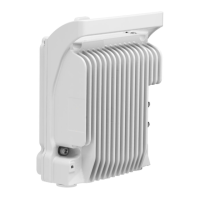
Do you have a question about the Ceragon FibeAir IP-20 All-Outdoor Series and is the answer not in the manual?
| Product Type | Wireless backhaul radio |
|---|---|
| Capacity | Up to 2 Gbps |
| Ingress Protection | IP67 |
| Frequency Bands | 6-42 GHz |
| Modulation | QPSK to 4096QAM |
| Operating Temperature | -45°C to +55°C |
Provides guidance on common issues and how to avoid them during device configuration.
Explains the HTTP web-based element manager for configuration, monitoring, and maintenance tasks.
Explains the importance of assigning dedicated IP addresses to IP-20 units for network planning.
Details how to connect the IP-20 unit to a PC via a TP cable for initial configuration.
Guides users on how to access the IP-20 unit's Web EMS by entering the default IP address and credentials.
Instructs on how to change the default Admin password and the importance of securing the unit.
Describes how to use the Platform Setup page in Web EMS to centralize basic platform configurations.
Explains how to configure in-band management to manage the unit remotely via its radio and/or Ethernet interfaces.
Provides CLI commands to change the management IP address of the local unit.
Details how IP-20 units use activation keys to enable future capacity growth and additional functionality.
Explains how to enable or disable Ethernet traffic interfaces, which are disabled by default.
Describes how MRMC radio scripts define radio capacity, modulation, and rates.
Guides on configuring radio parameters like frequency, TX level, and mute status via CLI.
Explains how to configure IP-20C and IP-20S units for FIPS 140-2 compliance.
Explains how to configure Multi-Carrier Adaptive Bandwidth Control for sharing multiple radio carriers.
Describes how to bundle E-Band and microwave radios into a group shared with an Ethernet interface.
Explains how to group physical interfaces into a single logical interface for load balancing and redundancy.
Details how to enable XPIC for two radio carriers to use the same frequency with polarity separation.
Explains how to configure unit protection including HSB radio and Ethernet interface protection.
Provides instructions on configuring MIMO and Space Diversity for IP-20C and IP-20C-HP units.
Explains how to configure ASD using BBC Space Diversity and beam forming technology.
Details how AFR works with ACM to achieve high modulations and capacities despite adjacent links.
Explains how to specify the IP protocol (IPv4 or IPv6) for unit communications.
Details how to configure the IP address, subnet mask, and default gateway of a remote unit.
Explains how to install and configure FTP/SFTP server software on a PC or laptop for unit operations.
Provides steps for downloading, installing, and upgrading IP-20 software and firmware releases.
Describes how to import, export, backup, and save IP-20 configuration files.